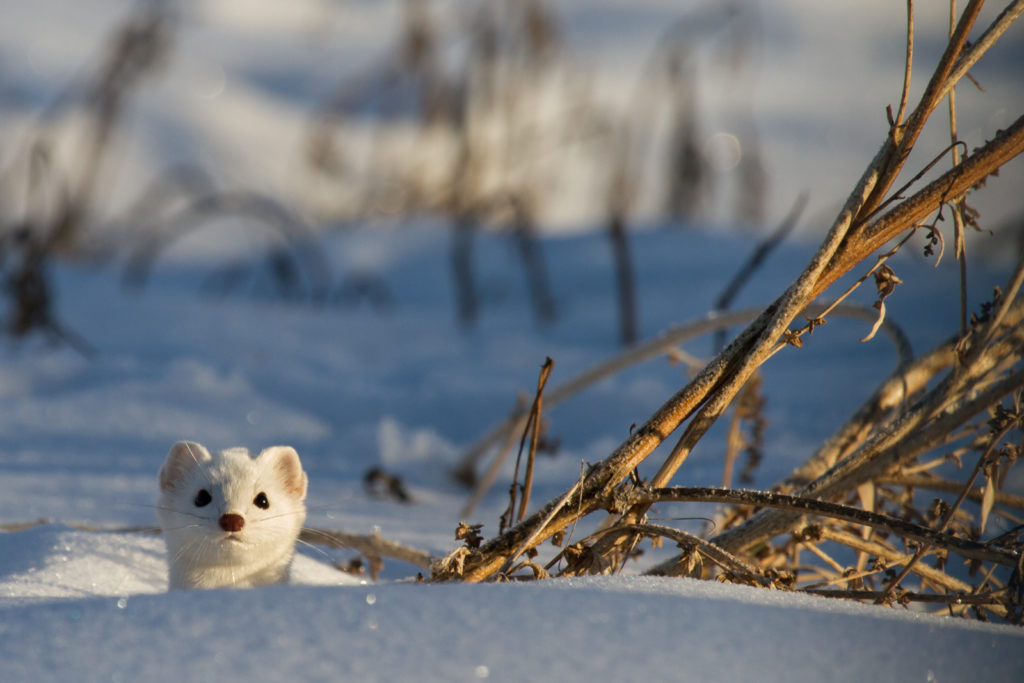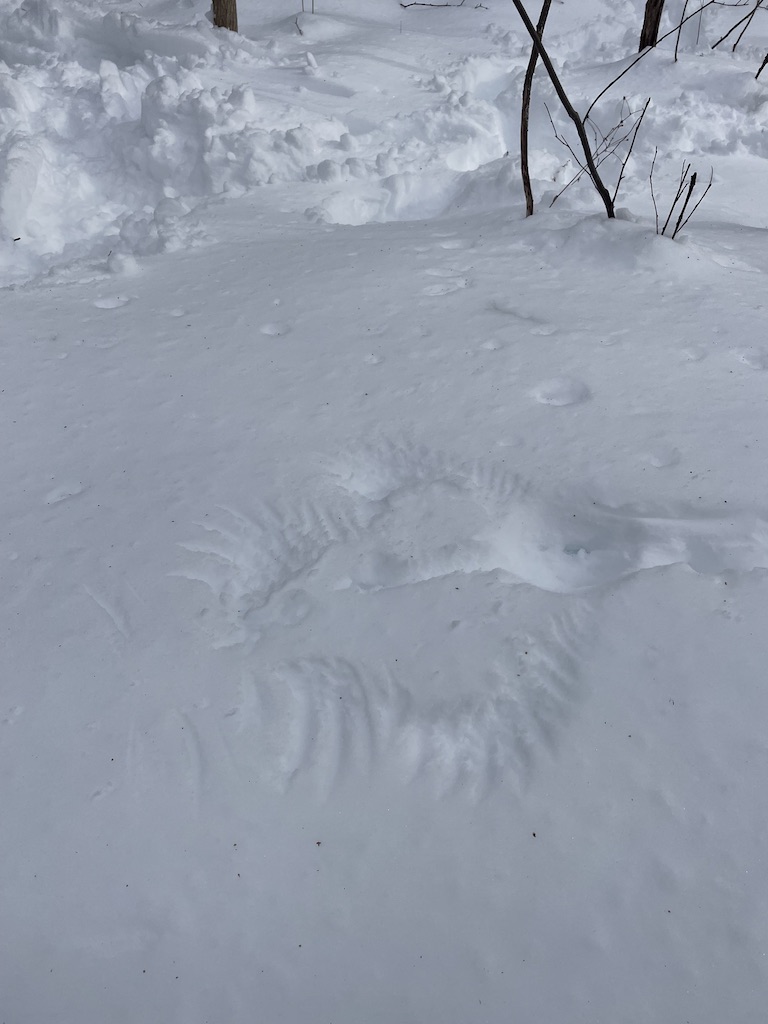Life Under the Snow
Written by Alicia Daniel, Vermont Master Naturalists
Our van full of field naturalists pulled into a snow-covered parking lot in the Vermont woods. Suddenly, the snow erupted in front of us. A white head and two front paws popped out. “An ermine!” We gleefully tumbled out of the van. The slim, short-tailed weasel with clear black eyes looked at us, looked at the snow in front of him, and looked at us again, as if weighing a decision. Then he turned and ran the opposite way. Something under the snow continued moving away from the fleeing weasel and toward us. One of us placed a boot in front of the wriggling snow. A meadow vole emerged and ran between the two leather boots, seeking shelter. We had interrupted a hunt and spared the vole’s life. And I caught a tantalizing glimpse into the magical, hidden world of life under the snow.

What was the meadow vole doing in the minutes leading up to the chase? And who else may be down there with him? Voles, mice, shrews, and other small animals live under the snow in the winter, where they build tunnels and cache food. Their compounds may contain a sleeping area, a breakfast nook, a food cache corner, and a latrine. Narrow tunnels connect everything.
Small mammals take advantage of the physics of snow to create these under snow homes. The subnivean zone is a hollow space between the ground and the base of the snowpack. As snow begins to accumulate in early winter, two factors help create air pockets under the snow. First, rocks and woody plants catch the early snowfall creating a space underneath them. Second, warmth radiating from the ground transforms the lowest lying layer of snow into water vapor, skipping the melting stage entirely. That water vapor freezes again when it contacts the snow overhead, crystallizing into a sturdy roof.
The fancy word for this is sublimation and the result is a zone of more open space that forms directly above the ground. All of this can take place with only six inches of snow on the ground! That’s right, it takes only six inches of snow for mice, voles, and shrews to have a sturdy roof over their heads and roomy living quarters below. As snow continues to accumulate, it truly “blankets” the earth, creating a cozy habitat for wintering animals. Air temperatures may plummet well below freezing, while the zone below the snow holds steady right around 32 degrees Fahrenheit, regardless of the temperature and weather conditions in the outside world. The snow provides them shelter that is generally safer and warmer than traveling out over the snow.
Let’s return to our encounter in the parking lot. What was the ermine doing right before the chase? Ermines are small enough to travel under the snow in these tunnels so they can locate their prey by scent, sound–or sight. They stalk small mammals silently and then surprise them. Ermines brown summer coat changes to pure white so it is hard to see them coming until it is too late. But since small mammals are sheltered out of sight from other larger predators, these animals have to rely on noise and scent to find them. Owls can hear mice, voles, and shrews running around underground from thirty yards away. With balled-up feet, they crash through the top crust and all the layers of snow to grab their prey. One of my favorite winter sights is wing prints on the snow, a snow angel, where an owl has landed and taken off after attempting to catch a small animal in the snow. Foxes and coyotes detect small mammals by scent. With an acrobatic pounce, these predators will jump up and dive in for their meal.

Small mammals listed on the Burlington Mammal Tracking Project include sightings of deer mice and meadow voles. A good place to look for signs of them is in the Intervale. During her time as Research Associate at the Intervale Center, Lina Swizlocki was using game cameras to monitor large mammals like bobcats and coyotes. She caught a large share of small mammals on film. The second most abundant category on most sites was one she called “mouse, vole or other rodent.” These small mammals are often hard to tell apart on trail camera photos. They are also hard to identify at a glance, which is often all we get. So how do we learn more about them?
One of the more interesting ways that naturalists learn more about their local small mammals is by looking in owl pellets. Owls often eat their prey whole or in large chunks. They bundle up the fur and bones in their craw and cough it up under their perch as a furry pellet about the size of a curled up mouse. I have pulled apart these pellets and found the jaws of small mammals. Shrews have jaws full of sharp little teeth. They are insectivores and use these shearing teeth to slice through the hard outer skeletons of insects. Shrews also have long snouts and tiny eyes which show up as small holes in their skulls unlike mice who have relatively large eye sockets. Mice jaws also have a rodent’s front teeth. These teeth have the front sides covered in hard orange enamel. The backs of the teeth do not have this covering. Therefore, teeth wear more quickly on the back side creating a chisel shape at the tip. Mice and other rodents use these chisel edges to gnaw into nuts and crack open seeds. Meadow voles however have teeth adapted to chewing grass. Their front teeth as well as their molars grow continuously and have sharp edges. (Moles with their big digging claws remain underground in the winter and rarely use subnivean tunnels.) If you want to know about identifying small mammals from the remains in owl pellets visit: https://www.youtube.com/watch?v=1cMUTo66btI
The life cycles of these creatures, great and small, depend entirely on the snow. The smaller ones couldn’t survive harsh winters without the warmth and protection afforded by the subnivean zone. The predators who depend on them as a food source wouldn’t find sufficient calories anywhere else. And this is just the tip of the iceberg! Snow affects our world in many fascinating ways. As spring progresses and all but the last few inches of snow melts, the ingenuity of subnivean survival is spelled out like a map: telltale depressions and bumps appear where tunnels and dwellings crisscrossed the field.
I was walking in the Intervale near the Winooski River one winter when my boot broke through the snow and a meadow vole ran over it. I pounced like a fox and came up with the vole in my mittened hands. We were both surprised. These fat, furry animals are often called the sausages of the food web. Every large carnivore wants to eat them. Despite having read Farley Mowat’s account of eating voles to replicate the diet of wolves in the Arctic, I didn’t have the faintest desire to eat a vole. Maybe I wasn’t hungry enough. I definitely was not hungry enough. I let it go on its furry way.
